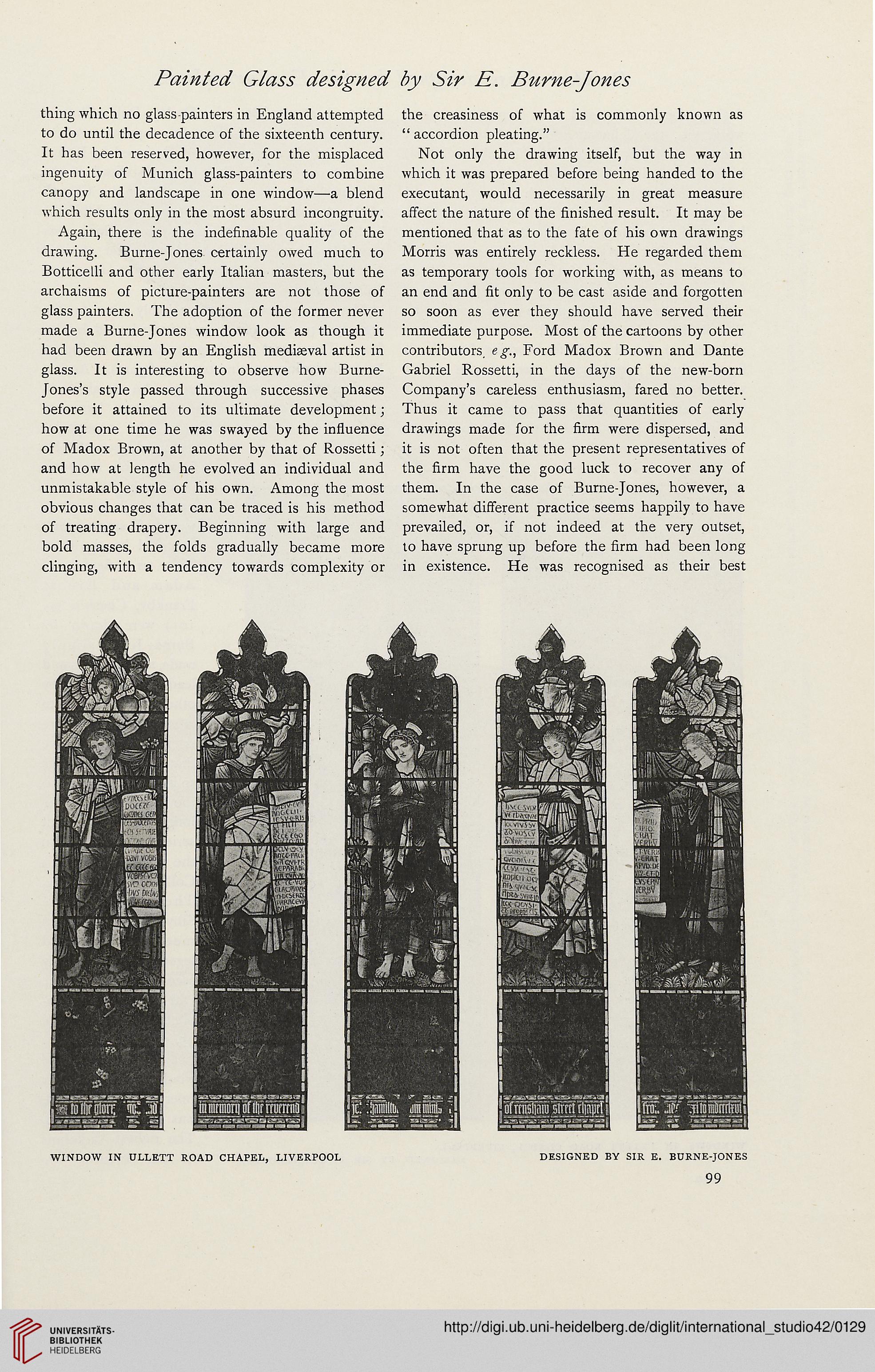Painted Glass designed by Sir E. Burne-Jones
thing which no glass-painters in England attempted
to do until the decadence of the sixteenth century.
It has been reserved, however, for the misplaced
ingenuity of Munich glass-painters to combine
canopy and landscape in one window—a blend
which results only in the most absurd incongruity.
Again, there is the indefinable quality of the
drawing. Burne-Jones certainly owed much to
Botticelli and other early Italian masters, but the
archaisms of picture-painters are not those of
glass painters. The adoption of the former never
made a Burne-Jones window look as though it
had been drawn by an English mediaeval artist in
glass. It is interesting to observe how Burne-
Jones's style passed through successive phases
before it attained to its ultimate development;
how at one time he was swayed by the influence
of Madox Brown, at another by that of Rossetti;
and how at length he evolved an individual and
unmistakable style of his own. Among the most
obvious changes that can be traced is his method
of treating drapery. Beginning with large and
bold masses, the folds gradually became more
clinging, with a tendency towards complexity or
the creasiness of what is commonly known as
" accordion pleating."
Not only the drawing itself, but the way in
which it was prepared before being handed to the
executant, would necessarily in great measure
affect the nature of the finished result. It may be
mentioned that as to the fate of his own drawings
Morris was entirely reckless. He regarded them
as temporary tools for working with, as means to
an end and fit only to be cast aside and forgotten
so soon as ever they should have served their
immediate purpose. Most of the cartoons by other
contributors eg., Ford Madox Brown and Dante
Gabriel Rossetti, in the days of the new-born
Company's careless enthusiasm, fared no better.
Thus it came to pass that quantities of early
drawings made for the firm were dispersed, and
it is not often that the present representatives of
the firm have the good luck to recover any of
them. In the case of Burne-Jones, however, a
somewhat different practice seems happily to have
prevailed, or, if not indeed at the very outset,
to have sprung up before the firm had been long
in existence. He was recognised as their best
WINDOW IN ULLETT ROAD CHAPEL, LIVERPOOL
DESIGNED BY SIR E. BURNE-JONES
99
thing which no glass-painters in England attempted
to do until the decadence of the sixteenth century.
It has been reserved, however, for the misplaced
ingenuity of Munich glass-painters to combine
canopy and landscape in one window—a blend
which results only in the most absurd incongruity.
Again, there is the indefinable quality of the
drawing. Burne-Jones certainly owed much to
Botticelli and other early Italian masters, but the
archaisms of picture-painters are not those of
glass painters. The adoption of the former never
made a Burne-Jones window look as though it
had been drawn by an English mediaeval artist in
glass. It is interesting to observe how Burne-
Jones's style passed through successive phases
before it attained to its ultimate development;
how at one time he was swayed by the influence
of Madox Brown, at another by that of Rossetti;
and how at length he evolved an individual and
unmistakable style of his own. Among the most
obvious changes that can be traced is his method
of treating drapery. Beginning with large and
bold masses, the folds gradually became more
clinging, with a tendency towards complexity or
the creasiness of what is commonly known as
" accordion pleating."
Not only the drawing itself, but the way in
which it was prepared before being handed to the
executant, would necessarily in great measure
affect the nature of the finished result. It may be
mentioned that as to the fate of his own drawings
Morris was entirely reckless. He regarded them
as temporary tools for working with, as means to
an end and fit only to be cast aside and forgotten
so soon as ever they should have served their
immediate purpose. Most of the cartoons by other
contributors eg., Ford Madox Brown and Dante
Gabriel Rossetti, in the days of the new-born
Company's careless enthusiasm, fared no better.
Thus it came to pass that quantities of early
drawings made for the firm were dispersed, and
it is not often that the present representatives of
the firm have the good luck to recover any of
them. In the case of Burne-Jones, however, a
somewhat different practice seems happily to have
prevailed, or, if not indeed at the very outset,
to have sprung up before the firm had been long
in existence. He was recognised as their best
WINDOW IN ULLETT ROAD CHAPEL, LIVERPOOL
DESIGNED BY SIR E. BURNE-JONES
99




